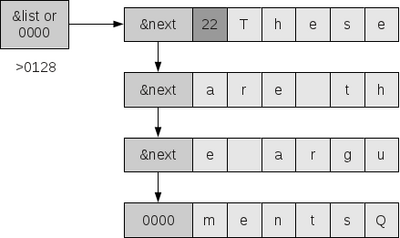Programming in MDOS
Extended Operations (XOPs)
MDOS makes frequent use of XOPs and offers them for user programs. An XOP (extended operation) is a special command of the TMS processor family which causes a context switch, transferring control to a location that is specified in a table.
Here are the details of the MDOS XOP Definitions.
Device access in TIC
Reading and writing disk sectors
The following code demonstrates how level-2 file access can be used in a TIC program. It copies a file, independent of the file format, by reading a sector and writing to a target file. Each sector is allocated when written.
This sample code is certainly not the best way to copy files (wasting a lot of time by repeatedly and writing single sectors); it is only intended to illustrate the level-2 access.
#include <stdio_h>
#include <stdlib_h>
main(argc, argv)
int argc; char *argv[];
{
int res, sect, i;
char rbuf[256];
int *ibuf;
if (argc<2)
{
printf("Syntax: filecopy <from_file> <to_file>\n");
return;
}
/* First we get the metadata */
res = bread(argv[1], 0, 0, rbuf);
check(res);
/* write the old metadata as new metadata */
res = bwrite(argv[2], 0, 0, rbuf);
check(res);
/* copy the file sector by sector */
ibuf = rbuf;
sect = ibuf[2];
for (i=0; i < sect; i++)
{
printf("Copying sector %d of %d\r", i+1, sect);
res = bread(argv[1], i, 1, rbuf);
check(res);
res = bwrite(argv[2], i, 1, rbuf);
check(res);
}
}
void check(code)
int code;
{
if (code != 0)
{
printf("Error, code = %d\n", code);
exit(7);
}
}
Getting the arguments from the MDOS command line
There is only little documentation on the MDOS environment. One of the most interesting questions is how to retrieve the command line arguments in order to process them in the own program. TIC seems to be able to do, so our assembly language program should as well.
The answer is that the command line arguments are stored as a single string (with leading length byte) in a linked list of chunks of 6 bytes each. The pointer to this list is at address >0128 of the memory page at 0000-1FFF that was set when the program was started (so take care when you change the mapper). Here is an illustration:
The command line arguments do not contain the program name, and they are not parsed, that is, you have to analyze the string in your application program. The memory location at >0128 contains a 0000 when there are no arguments. The end of the list is indicated by a next pointer that is set to 0000. Be aware that the last chunk may have arbitrary content after the end of the string. The pointers are 2 bytes each and start at word boundaries.
The following code is an example how to retrieve the list contents:
BUF BSS 80 Reserve 80 bytes of space
START MOV @>0128,R0 Get pointer to list
JEQ NOARGS If it is 0, skip all
ST1 LI R3,BUF Pointer to buffer
MOV *R0+,R1 Store next pointer in R1
LI R5,6 Number of bytes in chunk
MOVB *R0+,R2 Get length byte
DEC R5 Count down one for that byte
SRL R2,8 Move length byte to the low byte
MOV R2,*R3+ and write it at the head of the buffer
GL1 MOVB *R0+,*R3+ Copy the current byte to the buffer
DEC R2 Count down remaining string bytes
JEQ GOTALL Done?
GL2 DEC R5 No, count down chunk counter
JNE GL1 Chunk done?
GL3 MOV R1,R0 Yes, put the next address in R0
JEQ DONE Is it null?
MOV *R0+,R1 No, so there is another chunk
LI R5,6 Reset chunk counter
JMP GL1 End of loop
DONE ...
NOARGS ...
